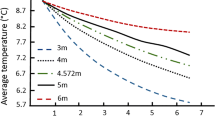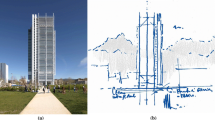Abstract
The low-enthalpy geothermal energy systems exploit the underground as a heat reservoir, by coupling it with highly efficient heat pumps: in winter, the energy stored in the subsoil can be transferred to the surface to heat buildings, whereas in summer the surplus heat in buildings can be transferred back to the ground providing a cooling action. Despite the high costs for installation, low-enthalpy geothermal systems have high energy efficiency and, therefore, contribute to energy saving, to the use of renewable energy sources, to environmental sustainability (the effects on the hydrogeological cycle are often negligible) and to the reduction in fuel consumption and in gas emissions. In this paper, a simple methodology is proposed to assess the geothermal potential of the underground of the Salento peninsula (southern Italy) at the regional scale, by calculating the equivalent thermal performance of the subsoil, which expresses the thermal power that is potentially extractable and useful to heat or cool a building. Since the possibility of exploiting the underground as a heat reservoir depends on the physical properties and water saturation of rocks, previous detailed studies on the hydrostratigraphic setup of the region are the basis for this analysis of geothermal potential. The equivalent thermal performance depends on the thermal efficiencies of different lithological units, whose ranges of values, for heating only, are provided in literature. For this case study, a stochastic approach has been applied: several combinations of thermal efficiencies were randomly selected from the intervals of reference values for every hydrostratigraphic formation and the corresponding minimum depths below the ground surface that must be reached to get the desired equivalent thermal performance are computed. The results show that the underground of the Salento peninsula has great potentialities for heating of buildings, except for some coastal areas because the saltwater intrusion phenomenon could cause problems for the realization of low-enthalpy geothermal energy systems.








Similar content being viewed by others
References
Bayer P, Saner D, Bolay S, Rybach L, Blum P (2012) Green house gas emission savings of ground source heat pump systems in Europe: a review. Renew Sust Energ Rev 16(2):1256–1267. doi:10.1016/j.rser.2011.09.027
Botteghi S, Chiesa S, Destro E, Di Sipio E, Galgaro A, Manzella A, Montanari D (2013) VIGOR: Prime indicazioni tecnico-prescrittive in materia di impianti di climatizzazione geotermica – VIGOR: Earlytechnical and prescriptiveindications with regard to geothermal air conditioningsystems. http://www.vigor.geotermia.it/
Chiasson AC, Rees SJ, Spitler JD (2000) A preliminary assessment of the effects of ground-water flow on closed-loop ground-source heat pump systems. ASHRAE Trans 106(1):380–393
Danis C (2014) Use of groundwater temperature data in geothermal exploration: the example of Sidney Basin, Australia. Hydrogeol J 22:87–106. doi:10.1007/s10040-013-1070-4
De Filippis G, Giudici M, Margiotta S, Mazzone F, Negri S, Vassena C (2013) Numerical modeling of the groundwater flow in the fractured and karst aquifer of the Salento peninsula (Southern Italy). Acque Sotterranee 2:17–28. doi:10.7343/AS-016-013-0040
DECC (2009) The UK renewable energy strategy. Department of Energy and Climate Change, London
DECC (2011) UK renewable energy roadmap. Department of Energy and Climate Change, London
Dethlefsen F, Ebert M, Dahmke A (2014) A geological database for parametrization in numerical modeling of subsurface storage in northern Germany. Environ Earth Sci 71:2227–2244. doi:10.1007/s12665-013-2627-1
Di Sipio E, Galgaro A, Destro E, Teza G, Chiesa S, Giaretta A, Manzella A (2014) Subsurface thermal conductivity assessment in Calabria (Southern Italy): a regional case study. Environ Earth Sci 72:1383–1401. doi:10.1007/s12665-014-3277-7
Dickson MH, Fanelli M (1990) Geothermal energy and its utilization. In: Dickson MH, Fanelli M (eds) Small geothermal resources. UNITAR/UNDP Centre for Small Energy Resources, Rome, pp 1–29
Erol S (2011) Estimation of heat extraction rates of GSHP systems under different hydrogelogical conditions. MSc. Thesis, University of Tübingen, Tübingen, Germany, 85 pp
Galgaro A, Di Sipio E, Destro E, Chiesa S, Uricchio VF, Bruno DE, Masciale R, Lopez N, Iaquinta P, Teza G, Iovine G, Montanari D, Manzella A, Soleri S, Greco R, Di Bella G, Monteleone S, Sabatino M, Iorio M, Petruccione E, Giaretta A, Tranchida G, Trumpy E, Gola G, D’Arpa S (2012) Methodological approach for evaluating the geo-exchange potential: VIGOR Project. Acque Sotterranee, 43–53. doi:10.7343/AS-014-12-0029
Giudici M, Margiotta S, Mazzone F, Negri S, Vassena C (2012) Modelling hydrostratigraphy and groundwater flow of a fractured and karst aquifer in a Mediterranean basin (Salento peninsula, southeastern Italy). Environ Earth Sci. doi:10.1007/s12665-012-1631-1
Goetzler W, Zogg R, Lisle H, Burgos J (2009) Ground-source heat pumps: overview of market status, barriers to adoption, and options for overcoming barriers. Final report, Energy Efficiency and Renewable Energy-Geothermal Technologies Program, USDE, Washington, DC
Goldstein B, Hiriart G, Tester J (2011) Great expectations for geothermal energy to 2100: messages for now. GRC Trans 35:1175–1183
Huenges E, Kohl T, Kolditz O, Bremer J, Scheck-Wenderoth M, Vienken T (2013) Geothermal energy systems: research perspective for domestic energy provision. Environ Earth Sci 70:3927–3933. doi:10.1007/s12665-013-2881-2
Kastner O, Sippel J, Scheck-Wenderoth M, Huenges E (2013) The deep geothermal potential of the Berlin area. Environ Earth Sci 70:3567–3584. doi:10.1007/s12665-013-2670-y
Lee KS (2014) Effects of regional groundwater flow on the performance of an aquifer thermal energy storage system under continuous operation. Hydrogeol J 22:251–262. doi:10.1007/s10040-013-1052-6
Lo Russo S, Civita MV (2009) Open-loop groundwater heat pumps development for large buildings: a case study. Geothermics 38:335–345
Lo Russo S, Civita M (2010) Hydrogeological and thermal characterization of shallow aquifers in the plain sector of Piemonte region (NW Italy): implications for groundwater heat pumps diffusion. Environ Earth Sciences 60:703–713. doi:10.1007/s12665-009-0208-0
Lo Russo S, Taddia G, Gnavi L, Verda V (2014) Neural network approach to prediction of temperatures around groundwater heat pump systems. Hydrogeol J 22:205–216. doi:10.1007/s10040-013-1072-2
Lund JW, Freeston DH, Boyd TL (2011) Direct utilization of geothermal energy 2010 worldwide review. Geothermics 40:159–180
Margiotta S, Negri S (2004) Alla ricerca dell’acqua perduta. Congedo editore, pp 192. (ISSBN 8880864785)
Margiotta S, Negri S (2005) Geophysical and stratigraphycal research into deep groundwater and intruding seawater in the mediterranean area (the Salento Peninsula, Italy). Nat Hazards Earth Syst Sci 5:127–136
Margiotta S, Mazzone F, Negri S, Calora M (2008) The role of integrated high resolution stratigraphic and geophysical surveys for groundwater modeling. Hydrol Earth Syst Sci Discuss 5:2859–2898
MCS (Microgeneration Certification Scheme) (2011) Microgeneration installation standard: MIS 3005 Issue 30. Department of Energy and Climate Change, London
Pearson SCP, Alcaraz SA, Barber J (2014) Numerical simulations to assess thermal potential at Tauranga low-temperature geothermal system, New Zealand. Hydrogeol J 22:163–174. doi:10.1007/s10040-013-1076-y
Pedron R, Sottani S, Vettorello L (2014) Numerical modeling of geothermal heat pump system: evaluation of site specific groundwater thermal impact. EGU 2014, Vienna
Provincia di Treviso and Università di Padova (2010) Geoscambio nella provincia di Treviso
Reina A (2012) Lo scenario tecnico ambientale della geotermia a bassa entalpia in Puglia. Green City Energy MED. Bari, 12-13 Novembre 2012. http://greencityenergy.it/attibari2012/MARTEDI13NOVEMBRE/PRODUZIONE%20ENERGIA%20RINNOVABILE/II%20SESSIONE/Alessandro_REINA.pdf
Sinergeo (2011) Studio del potenziale geotermico – Provincia di Vicenza
Sippel J, Fuchs S, Cacace M, Braatz A, Kastner O, Huenges E, Scheck-Wenderoth M (2013) Deep 3D thermal modelling for the city of Berlin (Germany). Environ Earth Sci 70:3545–3566. doi:10.1007/s12665-013-2679-2
Stauffer F, Bayer P, Blum P, Molina-Giraldo N, Kinzelbach W (2013) Thermal use of shallow groundwater. CRC Press, Boca Raton, p 290
Turcotte DL, Schubert G (2014) Geodynamics, 3rd edn. Cambridge University Press, Cambridge. ISBN 9780521186230
VDI-Richtlinie (2001) Thermal use of the underground, Blatt 2. Düsseldorf, VerainDeutscherIngenieure, VDI-Verlag
Author information
Authors and Affiliations
Corresponding author
Rights and permissions
About this article
Cite this article
De Filippis, G., Margiotta, S., Negri, S. et al. The geothermal potential of the underground of the Salento peninsula (southern Italy). Environ Earth Sci 73, 6733–6746 (2015). https://doi.org/10.1007/s12665-014-4011-1
Received:
Accepted:
Published:
Issue Date:
DOI: https://doi.org/10.1007/s12665-014-4011-1




